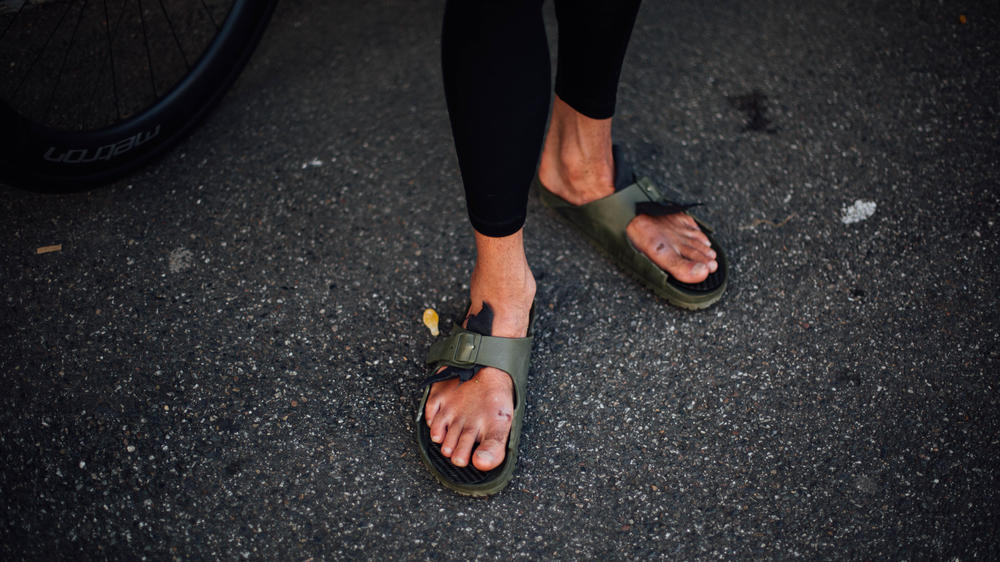Section Branding
Header Content
A Pro Cyclist Rode An Unofficial, Solo Tour De France And Beat The Pack
Primary Content
Pro cyclist Lachlan Morton wasn't officially in this year's Tour de France, but he rode the route anyway, by himself — and beat everyone to the finish in Paris by five days.
After starting shortly behind the official group on June 26, he crossed the unofficial finish line at 5:30 a.m. Tuesday: 3,424 miles in 18 days, including ascents up some of France's famously brutal mountains.
Morton rode around 200 miles each day, usually spending about 12 hours in the saddle before finding a place to camp for the night (or simply riding through the night).
"To go out and ride your bike really far one time is one thing, but then to sleep in a tent and wake up at 5 o'clock the next morning to do it all again and do that again 15 or 16 days, that's a huge challenge," he says, "and is every bit if not more difficult than I thought it would be."
For comparison, you can cross the continental U.S. on a bike in just over 3,000 miles, and for most people, it can take at least two months.
The team Morton rides for, the U.S.-based EF Education-Nippo, called it the Alt Tour. While the EF squad riding in the official Tour de France has mechanics and spare bikes at the ready, hotels to sleep in, all their meals provided and daily massages, Morton was left to his own devices.
A typical day on the Tour de France is about 100 miles. And in the official Tour, buses ferry riders from where one day's stage ends and the next day's stage begins. Morton rode those gaps himself, significantly adding to the total mileage.
There are two rest days on the Tour. Morton had none.
He carried all his clothes and gear on his bike, bought his own food and fixed his own flat tires.
There were profound moments, like having the road to himself, riding through a glorious sunrise in the Alps, when he "felt very lucky to be out there doing what I was doing."
But Morton faced profound challenges as well: rainy days and nights, going to sleep hungry, running out of supplies. Lots of pain.
"I got a sore knee on the first day, which was a pretty significant problem and something that I didn't have a lot of experience with," he tells NPR. He had the idea to buy wider, longer pedals (he actually had to buy a whole bike from a supermarket just to get the pedals) that let his feet move around more and ride in his sandals.
"It turned out to be the perfect solution for my knee problem," Morton says, but then it created another problem: "I got pretty significant blisters from the sandals."
But he made some modifications and was able to make do riding in sandals for most of the journey.
It was all to raise money for World Bicycle Relief, a nonprofit that provides bicycles to people who need them in developing countries.
It wasn't his first epic solo ride
It's only the latest zany idea for Morton, who specializes in off-the-beaten-path riding. He's done two of cycling's premier three-week Grand Tours before — the Giro d'Italia in 2020, and the Vuelta a España in 2017 — but gets the most attention for his solo adventures.
In 2019, he went from the bottom to the top of Great Britain, more than 1,200 miles, in under five days of cycling time. Last year, he rode through deserts and massive climbs up mountains on off-road trails in southern Spain, completing 446 miles in 43 1/2 hours, barely stopping at all. He has done epic rides through the Australian Outback, through the Balkans and in Colombia and set a record for the fastest known time on the Kokopelli Trail from Moab, Utah, to Loma, Colo.
A few months into the pandemic last year, with a lot of pro cycling at a standstill, Morton briefly held the record for Everesting — that is, riding a bike numerous times up one hill to reach a total vertical elevation the equivalent of Mount Everest.
He's far from the only bicyclist to embrace extreme endurance events recently. Endurance cyclist Jack Thompson has now overtaken the Tour de France after starting more than a week behind.
Among the many events that require riders to support themselves the whole way, there's the yearly Tour Divide, which runs from Banff, Alberta, Canada, to the U.S.-Mexico border in New Mexico — about 2,700 miles, done in under 14 days by Mike Hall. And the Trans Am Bike Race, from Oregon to Virginia, done in under 17 days by Abdullah Zeinab. Fiona Kolbinger rode from Bulgaria to France in just over 10 days to win the Transcontinental Race.
But Morton is notable for his platform, leading some to argue that his type of adventure, complete with video documentation, live GPS tracking and a social media boost, is the future of professional cycling.
There's always a place for events like the Tour, he says.
However, "I think there's definitely a space beyond that where you can have top athletes competing in events or challenges or riding their bikes in a way that is still inspiring in the distance or the speed, but it's also a lot more relatable to the way that most people use their bikes," Morton says. "I think the Tour de France is unattainable for 99.9% of athletes. And, you know, you could buy a bike and put some bags on it and go tour France and there's no one that can stop you."
Copyright 2021 NPR. To see more, visit https://www.npr.org.





